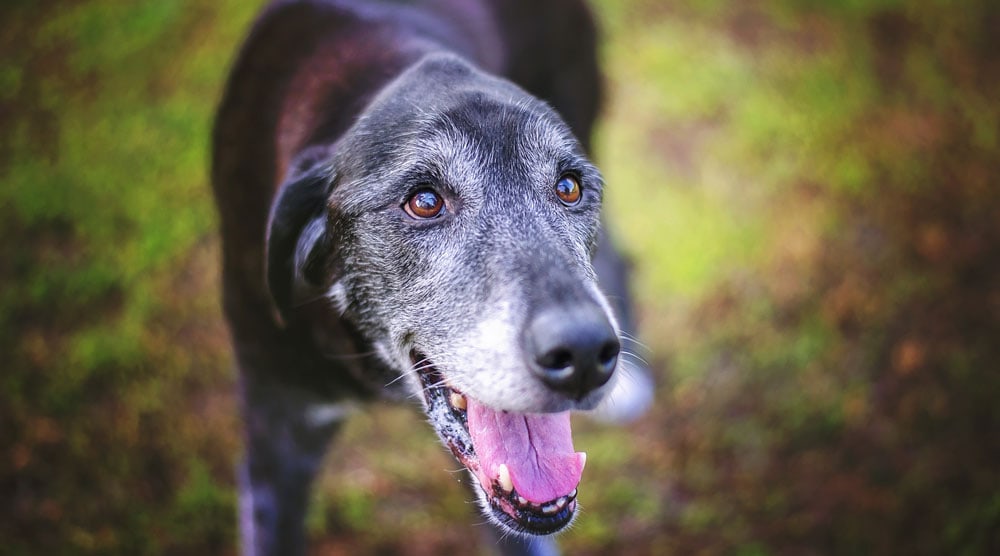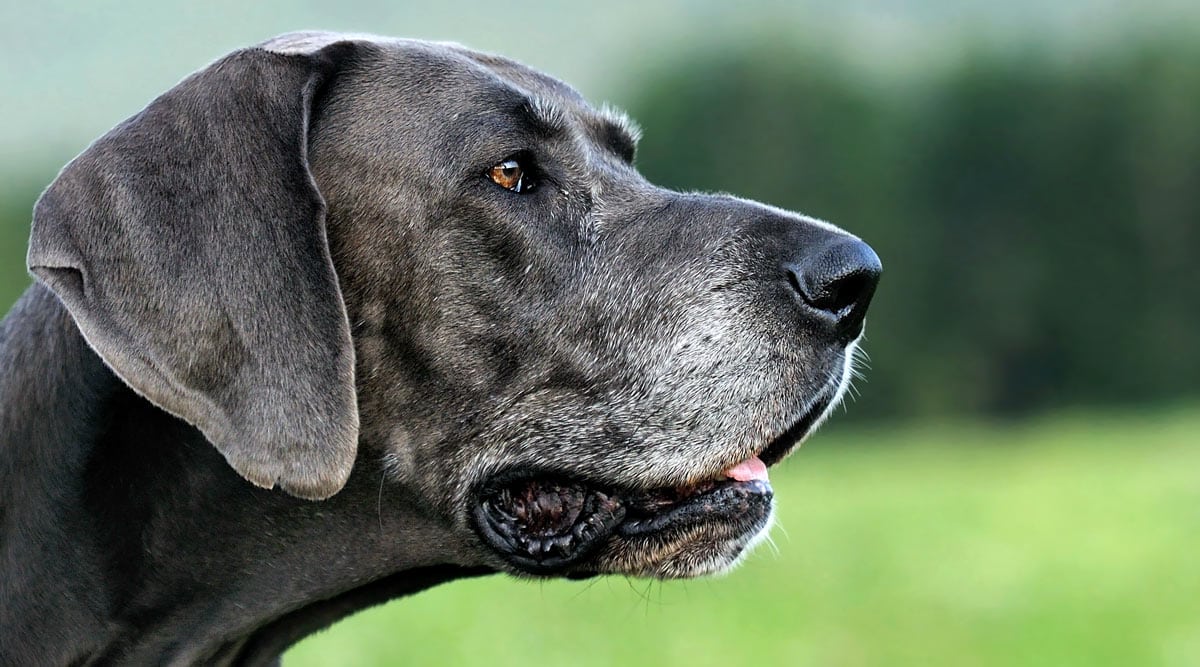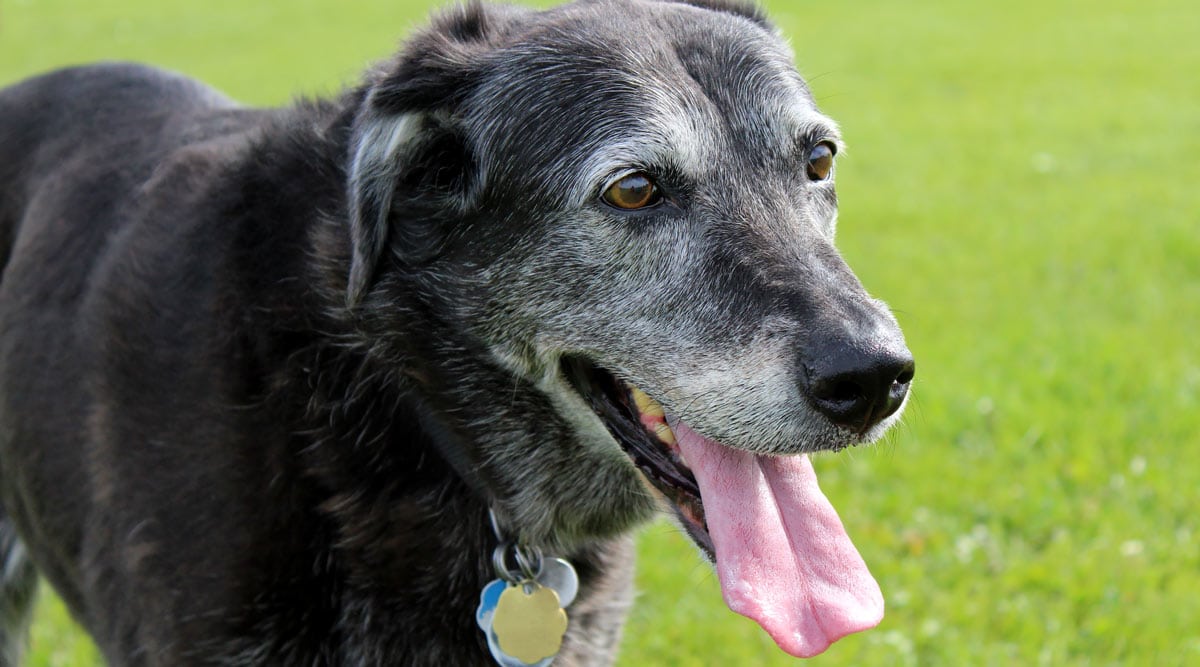It’s sadly common for elderly dogs to pace or become restless. This can be distressing for owners, especially as it’s not always obvious how to help your pet.
There are many reasons why an elderly dog might pace. A common example is canine cognitive dysfunction, which is similar to dementia in humans. It can cause confusion, disorientation, and repetitive behaviours.
Pacing can also be caused by physical pain, stress, boredom, or neurological issues. As there are many possible causes, it’s important to visit a vet if your senior dog is pacing a lot (or if pacing is combined with other symptoms of illness).
Contents
Why Is My Senior Dog Pacing? (And What To Do About It)

Dogs often walk around their home without appearing to have a specific goal. They might be scavenging for food, checking where family members are, or just seeing if anything interesting is happening.
Walking around the house is not the same as pacing though. When a dog paces, they walk in a repetitive loop, or sometimes back and forth in a straight line. Pacing typically lasts for an extended time and it may be difficult to distract the dog.
Pacing is a sign something is bothering your elderly pup. It’s not normal behaviour and shouldn’t be ignored.
1. Canine Cognitive Dysfunction
Canine cognitive dysfunction (CCD) is a common reason for pacing in senior dogs. As CCD is caused by a decline in cognitive abilities, it leads to behaviour changes, anxiety, and many other issues.
Any dog can suffer from CCD, and it becomes increasingly likely as the dog ages. In fact, a large study of over 15,000 dogs found that there was a 52% increase in the chance of CCD every year over the age of 10.
Pacing is a common side-effect of CCD. There can be several reasons for this:
- CCD affects the dog’s cognitive function, which can cause repetitive or abnormal behaviours.
- CCD makes dogs feel more anxious. This can make the dog feel restless and unable to settle.
- CCD causes confusion and disorientation, which can lead to the dog walking in circles.
- CCD often causes a dog to need the toilet more frequently, and they might pace when they need to go.
Aside from pacing, CCD may cause the dog to become unstable on their feet. It may be difficult to interrupt a dog with CCD who is pacing – almost like they are “zoned out.” The dog also might not notice potential dangers or objects in their path.
CCD affects every dog differently, but there are many other potential symptoms. Some examples include:
- Disorientation
- Altered sleeping patterns
- Changes in personality
- New behaviours (such as a previously quiet dog barking at nothing)
- Lower activity levels
- Changes in how the dog interacts with bonded people
- Toilet accidents
- Difficulty navigating the house (they may have trouble finding their food or water bowls)
- Restlessness
- Other repetitive behaviours
You should contact a vet if you notice any signs of CCD in your dog. While the condition isn’t curable, it can be managed with medication and other treatment methods.
Don’t resign yourself to CCD being a normal part of canine ageing. There are many ways to improve your dog’s quality of life and reduce symptoms.
2. Stress or Anxiety (Including Separation Anxiety)
When a dog is stressed, they experience elevated levels of stress hormones (such as cortisol) in the body. Stress hormones cause the dog to feel tense and ready for action, making it difficult to relax.
For these reasons, stress or anxiety can cause the dog to pace. This is similar to how humans struggle to sit still when nervous or anxious.
There are always other signs of stress combined with pacing or restlessness. These can include:
- Panting
- Whining or other vocalisations
- Lip licking
- Tail held between the legs
- Ears pinned back
Keep in mind that senior dogs may become stressed by situations that didn’t bother them when they were younger. This might be due to brain changes, loss of vision, or loss of hearing.
Separation anxiety, which is distress at being left alone, can also cause pacing. It’s possible for senior dogs to develop separation anxiety late in life, often as a consequence of CCD. Aside from pacing, the dog may also bark, have toilet accidents, or become destructive when you leave the house.
Contact a vet if your dog is suffering from ongoing stress or anxiety. The symptoms often mimic other conditions, so getting an accurate diagnosis is important. Stress can also sometimes be managed with medication.
Once you’ve ruled out medical conditions, you may need the help of a dog behaviourist to reduce your senior pup’s stress. A behaviourist can give you a training plan for problems such as separation anxiety or fear of loud noises (such as fireworks).
3. Pain or Discomfort
Senior dogs often struggle with joint pain. In particular, conditions such as osteoarthritis, rheumatoid arthritis, and hip dysplasia can cause chronic pain.
These conditions can make it difficult for the dog to settle into a comfortable position. The joints may stiffen up during rest, which forces the dog to move around more. And the weight of lying down can also put uncomfortable pressure on the joints.
Pain probably won’t cause the absent-minded pacing associated with CCD or neurological conditions. But some dogs may pace to keep their joints loose and avoid the discomfort of lying down.
Watch your dog for other signs of pain. These can include limping, licking the affected area, and whining. Keep in mind that the pain may be worse at different times of day or after physical activity.
Of course, you should always contact a vet if you suspect your pet may be in pain. Some medications can reduce pain and improve your dog’s quality of life, although the right option depends on the underlying condition.
You can also make your dog more comfortable by buying an orthopedic bed (which supports the joints) and keeping the room comfortably warm.
4. Boredom or Frustration
When bored, dogs may look for any activity or behaviour that can provide mental relief.
Pacing in circles is a common example, along with licking furniture or the floor. These behaviours aren’t mentally stimulating, but can distract the dog from frustration and boredom.
If you notice signs of boredom, then it’s vital to provide more mental and physical stimulation. Repetitive behaviours are worrying and indicate that your elderly dog lacks essential enrichment.
While it’s important to reduce a senior dog’s exercise to match their age and health, you’ll need to balance this with more mental stimulation. Some great examples include puzzle feeders, stuffed Kongs, and gentle games of tug.
Giving your dog plenty of attention and love can also make them feel happier and more secure.
Note: Senior dogs may also pace more when waiting for something, such as a loved one to return or dinner time.
5. Other Medical Conditions (Including Neurological Causes)
Senior dogs typically have more health conditions than younger dogs. Pacing can be a side-effect of a variety of medical issues, such as:
- Gastrointestinal issues. These can cause nausea or an upset stomach, which makes the dog restless and uncomfortable. A serious example is “bloat”, when the stomach twists and cuts off blood supply. It can cause drooling, pain, a swollen belly, and pacing. Bloat is a medical emergency, as fast surgery is often needed to give the dog a chance of survival.
- Allergies or skin parasites. Skin problems often cause itchiness, which makes it very difficult for the dog to relax. Allergies can be environmental, such as pollen, or related to food.
- Neurological conditions. Any condition that affects the brain could cause pacing. Neurological issues may also make the dog unstable and appear to sway when walking, along with vomiting and head tilting. Examples include strokes and brain tumours.
You should contact a vet immediately if you notice any signs of illness in your dog, or if pacing has recently increased.
Don’t try to treat the problem at home. It’s dangerous to try and diagnose a medical problem without blood tests, scans, and other veterinary equipment.
What Should You Do About Pacing In Senior Dogs?

You can’t address your dog’s pacing until you know what’s causing it. So, the first step is always to take them for a vet checkup to rule out medical conditions.
Try to record a video of your dog’s pacing. It can also help your vet if you note when the pacing happens, to see if a pattern emerges.
Here are some other tips if your senior dog is pacing:
- Don’t restrain, confine, or physically stop your dog from pacing. This won’t affect the underlying condition and can cause extra stress, making the problem worse.
- Make sure your dog is safe by removing dangerous items from near where they are pacing. You should also avoid leaving objects on the floor that might become trip hazards.
- Always stay calm and don’t get frustrated. Your dog is probably anxious or stressed, so getting angry will make the problem worse.
- Look for obvious reasons for stress that might be triggering the pacing. These can include fireworks, thunder, or a guest in the house.
- Don’t try to medicate with at-home remedies or medication. You should only give your dog treatments recommended by your vet.
- Never give a dog human medication or supplements, as these affect dogs differently and can be very dangerous.
If your vet has ruled out medical causes, or they suspect the issue is anxiety, then you should contact a canine behaviorist.
Important: Always get an emergency vet appointment if you notice pacing along with other signs of acute illness (such as drooling, vomiting, diarrhea, or instability).
Summary
Elderly dogs may pace for a variety of reasons. Canine cognitive dysfunction is one of the most common, as it affects many senior dogs and can lead to repetitive behaviours. Stress, pain, boredom, or neurological conditions can also cause this behaviour.
If you notice your dog pacing, then it’s always important to contact a vet. Pacing can be a sign of a serious medical condition, especially if other symptoms of illness accompany it.



